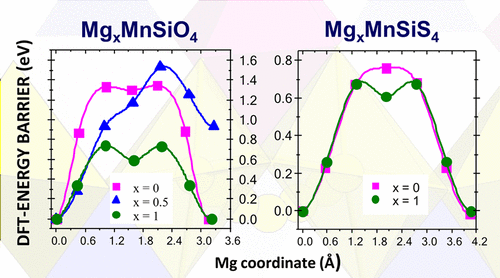当前位置:
X-MOL 学术
›
J. Phys. Chem. C
›
论文详情
Our official English website, www.x-mol.net, welcomes your
feedback! (Note: you will need to create a separate account there.)
Comparative Investigation of MgMnSiO4 and Olivine-Type MgMnSiS4 as Cathode Materials for Mg Batteries
The Journal of Physical Chemistry C ( IF 3.3 ) Pub Date : 2018-04-11 00:00:00 , DOI: 10.1021/acs.jpcc.8b02369 A. Torres 1 , M. E. Arroyo-de Dompablo 1
The Journal of Physical Chemistry C ( IF 3.3 ) Pub Date : 2018-04-11 00:00:00 , DOI: 10.1021/acs.jpcc.8b02369 A. Torres 1 , M. E. Arroyo-de Dompablo 1
Affiliation

|
The identification of potential cathode materials is necessary for the development of a new magnesium-based battery technology. Most attempts focus on oxide and sulfide materials, which in general suffer, respectively, of poor Mg mobility and low intercalation voltage. New chemistries should be explored. In this work, we investigate the basic electrode characteristics of olivine-type thiosilicates MgMSiS4 (M = Fe, Mn) with the double challenge of (1) raising the low intercalation voltage of transition metal sulfides and (2) improving the poor Mg diffusion of the oxosilicate counterparts MgMSiO4 (M = Fe, Mn). Density functional theory (DFT) calculations corroborate both expectations. The calculated average Mg deintercalation voltage for MgMnSiS4 (2.31 V) is above that of virtual MgMnS2 compounds (around 1.8 V), accounting for the inductive effect of the Si4+ ion on the transition metal. The calculated energy barriers for Mg diffusion in MgxMnSiO4 are 0.75 eV at x ∼ 1 and higher than 1.1 eV at x ∼ 0 and x = 0.5. The energy barriers decrease to 0.68 and 0.76 eV in MgxMnSiS4 (x ∼ 0, 1), thanks to the more covalent Mn–S bond (compared to the Mn–O bond) that renders less oxidized Mn ions, therefore favoring Mg2+ mobility. Although these results are promising, more work is needed to ensure the potential application of thiosilicates as cathode materials for Mg batteries.
中文翻译:

MgMnSiO 4和橄榄石型MgMnSiS 4作为镁电池正极材料的比较研究
潜在的阴极材料的识别对于开发新的镁基电池技术是必要的。大多数尝试集中在氧化物和硫化物材料上,它们通常分别遭受较差的Mg迁移率和较低的插层电压。应探索新的化学方法。在这项工作中,我们研究橄榄石型硫代硅酸盐MgMSiS 4(M = Fe,Mn)的基本电极特性,其双重挑战是(1)提高过渡金属硫化物的低嵌入电压和(2)改善不良的Mg扩散含氧硅酸盐对应物MgMSiO 4(M = Fe,Mn)。密度泛函理论(DFT)的计算证实了这两个期望。计算出的MgMnSiS 4的平均Mg脱嵌电压(2.31 V)高于虚拟MgMnS 2化合物(约1.8 V),这说明了Si 4+离子对过渡金属的感应作用。在镁Mg的扩散所计算的能量壁垒X MnSiO 4是在0.75电子伏特X〜1,并在高于1.1eV的X〜0和X = 0.5。的能垒降低到0.68和0.76 eV的在Mg中X MnSiS 4(X〜0,1),由于呈现较少氧化Mn离子,因此有利于镁的多个共价的Mn-S键(相对于锰-O键)2+流动性。尽管这些结果令人鼓舞,但需要做更多的工作来确保硫代硅酸盐作为镁电池正极材料的潜在应用。
更新日期:2018-04-11
中文翻译:

MgMnSiO 4和橄榄石型MgMnSiS 4作为镁电池正极材料的比较研究
潜在的阴极材料的识别对于开发新的镁基电池技术是必要的。大多数尝试集中在氧化物和硫化物材料上,它们通常分别遭受较差的Mg迁移率和较低的插层电压。应探索新的化学方法。在这项工作中,我们研究橄榄石型硫代硅酸盐MgMSiS 4(M = Fe,Mn)的基本电极特性,其双重挑战是(1)提高过渡金属硫化物的低嵌入电压和(2)改善不良的Mg扩散含氧硅酸盐对应物MgMSiO 4(M = Fe,Mn)。密度泛函理论(DFT)的计算证实了这两个期望。计算出的MgMnSiS 4的平均Mg脱嵌电压(2.31 V)高于虚拟MgMnS 2化合物(约1.8 V),这说明了Si 4+离子对过渡金属的感应作用。在镁Mg的扩散所计算的能量壁垒X MnSiO 4是在0.75电子伏特X〜1,并在高于1.1eV的X〜0和X = 0.5。的能垒降低到0.68和0.76 eV的在Mg中X MnSiS 4(X〜0,1),由于呈现较少氧化Mn离子,因此有利于镁的多个共价的Mn-S键(相对于锰-O键)2+流动性。尽管这些结果令人鼓舞,但需要做更多的工作来确保硫代硅酸盐作为镁电池正极材料的潜在应用。











































 京公网安备 11010802027423号
京公网安备 11010802027423号